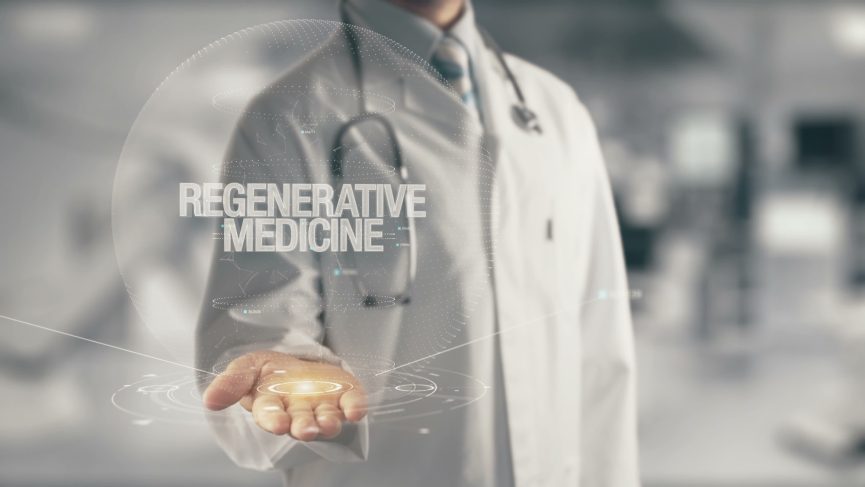Although regenerative therapy is a relatively new market, it was valued at $10,107 million in 2020 and will hit $83,196 million by 2030.
This is no accident. Regenerative therapy is one of the most promising treatment methods and is developing more every day. It’s great for naturally healing different types of pain and injuries and allows the body to regenerate on its own.
In this article, we’ll break down different types of regenerative therapy so that you can be more informed about this form of alternative pain management.
Stem Cell Treatment
By now, you have most likely heard of stem cell treatment. This is a type of regenerative therapy that utilizes a specific type of cell to repair injuries in the body. It is common for treating lingering pain in the back while regenerating tissues in the spinal discs.
What’s so special about stem cells is that they don’t actually have a specific function in the body. Instead, they will form into the exact type of cell that you need to serve a specific function.
When placed in a specific environment in the body, stem cells will transform to meet a certain need. For example, if they are placed near a damaged Achilles tendon, they should turn into Achilles tendon cells.
Stem cells are typically collected from the patient’s own bone marrow, blood, or fat. Next, they are placed into a machine called a centrifuge. This helps the doctor separate the cells and identify which ones are right for regenerative therapy treatment.
Some other companies will collect stem cells from other places like the placenta or cord tissue, or amniotic fluid. However, Doctors need to observe them closely or they will die during transport or storage.
The chosen cells are then injected into the body where there is chronic pain relief. For instance, for those that suffer from back pain, the doctor will inject them right into the area with the damaged disc. The cells will develop into new spinal disc cells.
Cartilage Regeneration
Another type of regenerative therapy is cartilage regeneration. This regeneration is great for those with musculoskeletal conditions.
It aims to heal damaged cartilage. This is no easy task because cartilage does not heal well on its own. It doesn’t contain blood vessels, meaning that blood can’t access the damaged parts regularly.
There are many options for cartilage regeneration, including:
- Membrane-induced Autologous Chondrocyte Implantation (MACI)
- Osteochondral Grafting
- Osteoarticular Transfer System (OATS) Procedure
- Osteotomy
These different options target different types of damaged cartilage, like those in the knees, underlying bones, and joints.
Depending on the treatment, they will use different techniques. Some will make small cuts in the bone where the injury is to draw blood and facilitate more cell growth. Others will transplant cartilage into the patient’s body. They might also implant man-made tissue into the cells to help them grow.
Platelet-Rich Plasma (PRP)
In the human body, the plasma and platelets found in blood are used to repair and heal injuries. Platelet-rich therapy is based on this idea. The most common uses of PRP injections help fix injuries to tendons in sports medicine.
In order to create platelet-rich plasma, a doctor will draw blood from the patient. They will then process it to create a more concentrated solution that has more plasma and platelets than normal blood. This is also done in a centrifuge.
After the PRP is created, it is then injected back into the tendon that needs to be repaired or applied directly during surgery.
It’s important to note that not all PRP is the same. Each therapy varies depending on factors such as the method of blood processing, the differences in the patient’s blood, or the use of other substances.
Prolotherapy
Inflammation naturally occurs in the body to increase blood flow to injured spots so that it attracts new cells to heal damaged tissue. Sports injuries like ligament sprains often cause inflammation, but they will usually subside before the injury is fully healed.
Prolotherapy is based on this idea.
To treat the injured spot, the doctor will create a watery solution that includes things like dextrose and saline. Doctors inject it into the injured area along with numbing agents like lidocaine.
The injection is actually designed to irritate the site of the injury. This then triggers the body’s natural healing response, causing it to replenish itself with new connective fibers. Ultimately, the body heals the damaged tissues and joints on its own.
Prolotherapy treats injured connective tissues and joints. It is a common treatment for injuries like:
- Whiplash
- Arthritis
- Degenerative disc disease
The great thing about prolotherapy is that it can be used in many different areas of the body, including the shoulders, neck, back, hip, hands, and knees.
Is Regenerative Therapy Right For Me?
There are many factors to consider when choosing if regenerative therapy is right for you.
The first thing to note is that these treatments are usually not covered by insurance, so most patients must pay out of pocket. Depending on the treatment, an injection can cost anywhere from $100 to over $5,000. Make sure to research how many injections you need for your treatment.
You’ll also want to look into the physician that is performing the therapy to make sure they have a solid track record for the treatment they will be performing.
Make sure to speak to a doctor about any potential risks, benefits, and recovery time associated with the treatment plan you want.
Access Your Body’s Self-Healing Powers
Those are the four types of regenerative therapy that are available. If you suffer from any form of chronic pain in the elbow, knee, back, ankle, or shoulder, regenerative therapy might be the answer you’ve been looking for.
If you’re ready to see what regenerative therapy can do for you, contact us today!

